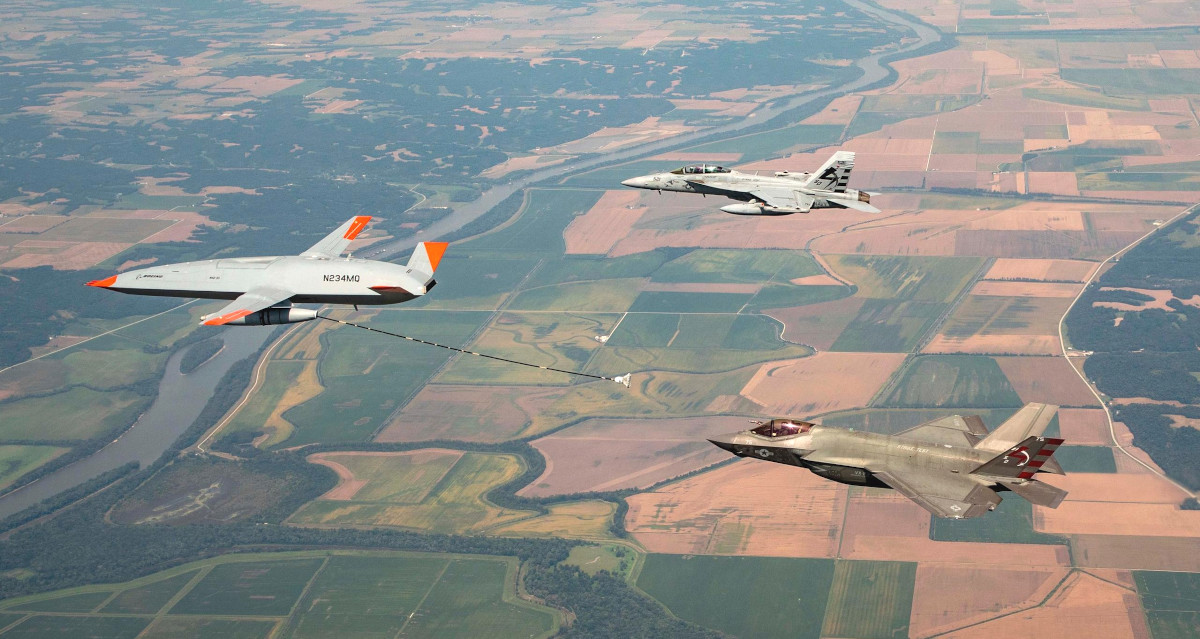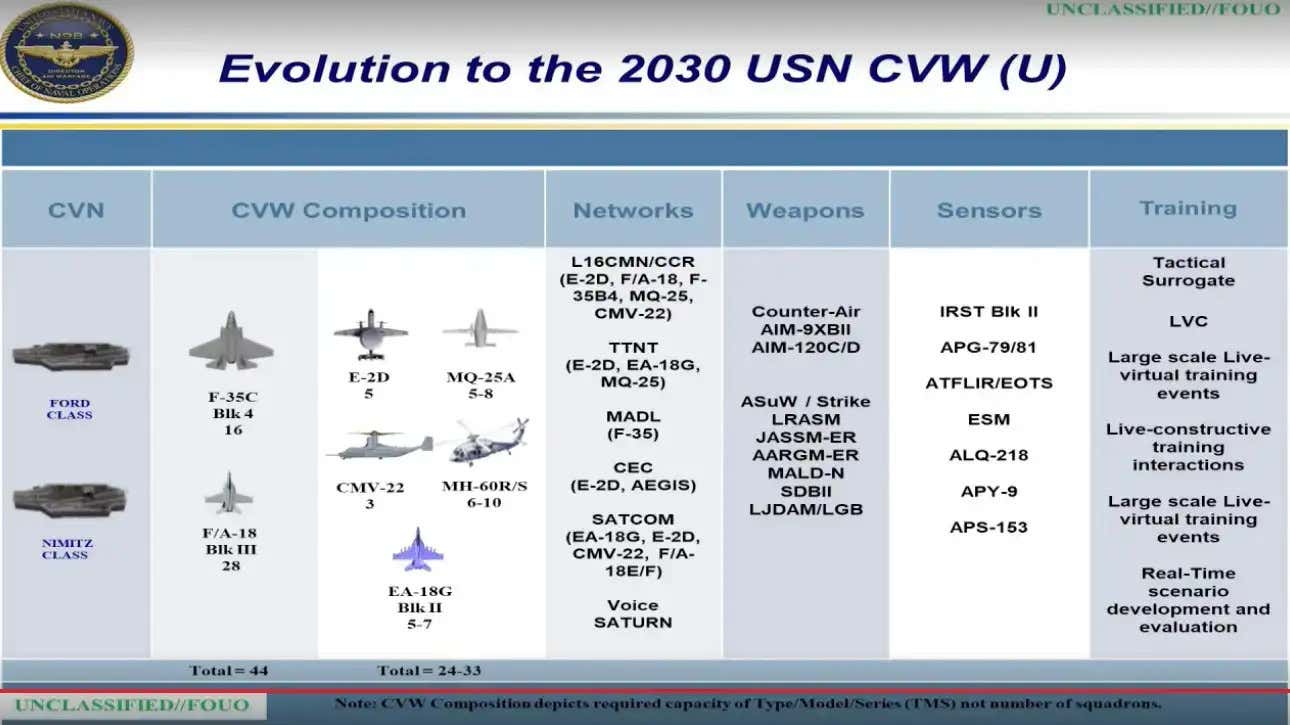The U.S. Navy’s new MQ-25 Stingray carrier-based tanker drone demonstrator has now refueled the F-35C Lightning II, as the program continues to rack up milestones on its path to frontline service. Topping up the carrier variant of the Joint Strike Fighter means that the EA-18G Growler electronic warfare jet and the CMV-22B Osprey tilt-rotor are the only probe-equipped receiver in the service's modern carrier air wing that has yet to link up with the Stingray test article, also known as T1. Previous refueling trials were conducted this summer between the MQ-25 and the F/A-18F Super Hornet and E-2D Advanced Hawkeye, which has added a new refueling capability in recent years.
This latest aerial refueling trial was conducted on September 13 near MidAmerica St. Louis Airport in Mascoutah, Illinois. The effort was led by the Unmanned Carrier Aviation program office (PMA-268) with Naval Air Systems Command (NAVAIR) and involved a combined Navy/Boeing team, in coordination with the F-35 program.
“Every T1 flight with another Type/Model/Series aircraft gets us one step closer to rapidly delivering a fully mission-capable MQ-25 to the fleet,” said Navy Captain Chad Reed, the PMA-268 program manager. “Stingray’s unmatched refueling capability is going to increase the Navy’s power projection and provide operational flexibility to the carrier strike group commanders.”
The test involving the MQ-25 and F-35C was only the third mid-air refueling flight for the T1 test aircraft, with the two previous sorties, as already noted, having trialed compatibility with the F/A-18F strike fighter and the E-2D radar plane. Bearing in mind the similarities between the F/A-18F and EA-18G, it is not currently clear if the electronic attack jet will require a separate receiver test with the MQ-25.
This was also the 36th test sortie in total for the T1. In addition, many more hours of refueling test work have been achieved with simulations using MQ-25 digital models.
The latest test event was a three-hour flight, with the F-35C flown by a pilot from the Navy’s Air Test Wing and Evaluation Squadron Two Three (VX-23). The stealth jet approached the drone, flying formation evaluations, wake surveys, and drogue tracking. Finally, the F-35C pilot plugged their jet into the MQ-25 test asset at a speed of 225 knots and an altitude of 10,000 feet. Fuel transfer was selected from a ground control station.

Testing the ability to refuel different carrier-based types from an unmanned drone is an entirely new development for the service and is vital to ensure that the Stingray is compatible with the different aerodynamic and performance characteristics of different receiver aircraft. As for the ARS pod, this is more familiar, being the same store, developed and produced by Cobham, that’s carried by F/A-18s outfitted as tankers.
After these three refueling tests, the T1 test article will undergo modifications ahead of its next big test event — going aboard an aircraft carrier this winter. The Navy says the drone needs to have a system integrated onto it that will enable personnel to move it around the deck.
What carrier will be used for these deck-handling tests is unclear. The Navy has said in the past that four flattops are set to be modified with the Unmanned Carrier Aviation Mission Control System (UMCS) necessary to operate the MQ-25 and that Nimitz class USS George H.W. Bush (CVN-77) will be the first to receive that upgrade.
The Navy needs the MQ-25 not only to free up F/A-18F jets currently assigned to the refueling mission, and to preserve Super Hornet fatigue life, but also to extend the range of both the Super Hornet and the F-35C. This would be a prerequisite of any future conflict with a near-peer opponent, especially one in the broad expanses of the Asia-Pacific theater against China. Now that the plan to outfit the Block III Super Hornet with conformal fuel tanks has been dropped, the need for an organic tanker within the carrier air wing has only been increased.
As well as reinstating a dedicated tanker asset to the carrier air wing, the MQ-25’s significance lies in it being the first operational carrier-based unmanned aircraft to go aboard a carrier. While the scope of its missions is much reduced from the original Unmanned Carrier Launched Airborne Surveillance and Strike (UCLASS) program, the Navy has confirmed that it expects the MQ-25 to take on additional missions, including intelligence, surveillance, and reconnaissance (ISR) duties.
It should also pave the way toward more sophisticated integration of manned aircraft and drones, or what the Navy describes as manned and unmanned teaming (MUM-T). Ultimately, as The War Zone has explored in the past, the MQ-25 could be well-positioned to take on additional missions in the future, too.
The introduction of the MQ-25 is part of a wider doctrinal shift within the carrier air wing, or CVW, in which unmanned platforms will play an increasingly important role. The Navy is now looking to move to a 40-60 unmanned-manned split, before achieving a 60-40 unmanned-manned split in the long term. This is a change from previous proposals for a CVW in 2030, as seen in the graphic below, in which manned aircraft were still very much in the majority. How the forthcoming F/A-XX fighter fits in with these revised ideas remains to be seen, although it is noteworthy that the Navy is also considering potential unmanned options as it looks to replace its Super Hornets under its iteration of the Next Generation Air Dominance program.

In the meantime, production is being kicked off with a first batch of four Engineering and Manufacturing Development (EMD) aircraft that are being completed under a 2018 contract award, to which another three MQ-25s have since been added.
The EDM aircraft will be used for further testing at the Boeing facility in St. Louis, Missouri before transiting to Naval Air Station Patuxent River, Maryland, for the rest of the flight test program, although there will also be tests undertaken at Lakehurst, New Jersey, and Eglin Air Force Base, Florida.
There have been some delays to the program, affecting the delivery of a first EDM aircraft, with Boeing pausing work to optimize weight and strength, address an unspecified quality issue, and as a result of the effects of the COVID-19 pandemic. The first EDM aircraft is now expected to be delivered in the fall of 2022.
Thereafter, if all goes to plan, the Navy expects to field 72 MQ-25s, and to achieve initial operating capacity in Fiscal Year 2025. After that, the sight of Stingrays refueling carrier-based Navy aircraft is set to become much more familiar.
Contact the author: thomas@thedrive.com
